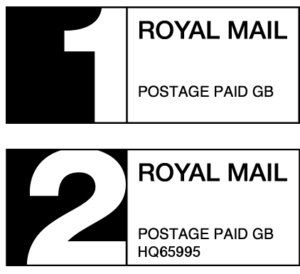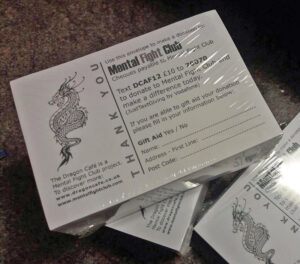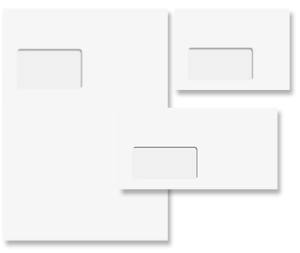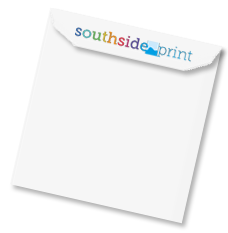Envelopes – A Comprehensive Guide
Having recently produced some overprinted C6 envelopes for local client The Dragon Café, we thought we’d put together a useful ready-reference guide to envelopes. We’ve included information on available shapes, sizes, formats, sealing mechanisms, styles, materials and more. There is also a note about overprinting options for those who need their own, unique envelope, perhaps showing their branding or allowing the envelope to serve a specific purpose, for example for collecting donations (see The Dragon Café’s fundraising example, shown below right). Take a look below and bookmark this page if you think it might be useful for future reference — we hope so!
 Envelope Sizes
Envelope Sizes
The three most popular size conventions for envelopes are ‘ISO C’ (‘C’ for short), ‘DL’ and square envelopes and we’ll explain how they work in a moment. There is also a fourth range, being the ‘ISO D’ sizes (used to suit ‘ISO B’ paper sizes) but they’re rarely used in the UK, so we’ll not go into detail about those here.
‘ISO C’ Sized Envelopes
You will be almost certainly be familiar with A4, A3 and A2 sized papers. These come from the ‘ISO A’ series of paper sizes. ‘ISO C’ sizes are a complementary range of sizes that are widely used with envelopes to house ‘A’ sized papers. So, for example, an unfolded A4 letter would fit neatly inside a C4 envelope (with a little breathing space). Meanwhile, if you fold an A4 letter in half (so it’s now A5), it would fit perfectly into a C5 envelope. If folded again into A6, it would fit nicely in a C6 envelope, and so on. Here are the most popular ISO C envelope sizes:
- C3 envelopes are 458mm x 324mm
- C4 envelopes are 324mm x 229mm
- C5 envelopes are 229mm x 162mm
- C6 envelopes are 162mm x 114mm
Now we’ll come onto what happens if you fold that A4 letter into three rather than two …
ISO ‘DL’ and ‘DLE’ Envelope Sizes
The envelope size 220mm x 110mm is commonly referred to by stationers and printers as ‘DL’ (short for DIN Lang, meaning DIN ‘Long’). It’s a perfect size to suit A4 letters folded into three. However, strictly speaking, true ‘DL’ is actually exactly one-third A4 i.e. 210mm x 99mm but true DL is seldom, if ever, used in the UK. So when we refer to ‘DL envelopes’ when speaking with stationers or printers in the UK, it’s understood that we’re really talking about ‘DLE’ size (the true name for 220mm x 110mm). It’s one of life’s little quirks!
Square Envelopes
The UK enjoys a huge range of different square envelope sizes. They are too numerous to list in full but the most popular among them include:
- 80mm square
- 100mm square
- 105mm square
- 110mm square
- 116mm square
- 120mm square
- 126mm square
- 130mm square
- 140mm square
- 155mm square
- 160mm square
- 164mm square
- 220mm square
- 240mm square
- 254mm square
- 317mm square
Envelope Opening Formats
When ordering envelopes from your printer or stationer, they may ask you whether you require ‘wallet’ or ‘pocket’ format. But what does that mean? ‘Wallet’ format simply means that, like a real wallet, the opening is on the longer edge. In contrast, ‘Pocket’ envelopes have their opening flap on the shorter edge. Of course, if they ask the same question about square envelopes, it’s a trick question — they’re making a joke because the sides are all the same length!
 Window Envelopes
Window Envelopes
‘Window’ envelopes, as the name suggests, feature a window opening, with a transparent plastic or cellophane type material spanning it, in the front face of the envelope. They are great time-savers because, if you position the address and recipient carefully on the document inside, it will show through the transparent window so there will be no need to produce a separate address label or to write on the envelope. Envelope windows come in various positions for the most popular envelope sizes, so care needs to be taken when ordering them if your documents have recipients and addresses in a particular position within your document templates.
 Overprinted & Branded Envelopes
Overprinted & Branded Envelopes
At Southside Print we can also overprint your envelopes in black and white or full colour, whether that’s on the front, back, on the flap or all three. Overprinting is a great way to maximise your brand’s recognition to prospects, customers and suppliers and they’ll know who the sender is the moment the envelope arrives, reinforcing brand awareness. Return addresses can also feature, of course, perhaps on the flap or back of the envelope.
 Overprinting also allows you to use envelopes for fundraising and donations (see the photograph above as an example of that) plus other purposes where information printed on the envelope will allow it to be more than just an ordinary mailing envelope.
Overprinting also allows you to use envelopes for fundraising and donations (see the photograph above as an example of that) plus other purposes where information printed on the envelope will allow it to be more than just an ordinary mailing envelope.
It goes without saying, too, that overprinting also lends itself to pre-paid mailings through the use of freepost addresses or a PPI (Printed Postage Impressions) licence printed on the front of your envelopes. For large quantities of mail, printing a PPI on your envelopes may even save you money and, as such, represents a sensible alternative to franking.
Let us know if you’d like a quotation for overprinted envelopes.
Envelope Styles & Materials
There is a vast array of materials and styles used for envelopes. If you are looking for something fairly standard, paper envelopes come in various colours, thicknesses and weights. If you would like something a bit more fancy, lined envelopes are sure to impress (great for wedding stationery, invites and similar). Perhaps you need something virtually indestructible. If so, consider Tyvek® envelopes as these are virtually impossible to tear, yet appear similar to paper. Then, of course, you might consider opaqued envelopes if security and privacy is paramount. These have a random or opaque pattern or texture printed on the inside so that it’s not possible to read what’s written on the contents even if the sealed envelope is backlit with a strong light. Security envelopes are a little different and often include tamper-proof features. At the more contemporary end, you can choose metallic foil envelopes in a range of funky colours and the same is true if you’d like those to be protective too – then choose foil bubble envelopes which are like a hybrid between metallic foil and ‘bubble wrap’ style envelopes. This is just the tip of the iceberg, though, so contact us if you’d like to discuss the options or obtain a price.
Envelope Sealing Mechanisms
Last but not least, consider the way in which your envelopes seal shut. Choose traditional gummed if you’re happy to lick or dampen every flap before closing. If not, choose peel & seal envelopes which allow you to simply peel off a strip so as to expose the underlying glue strip (rather like double-sided tape) then seal quickly and easily. Self-seal envelopes are similar in terms of the result but instead use pressure-sensitive pre-applied glue that requires nothing to be peeled — just press down the flap and it seals shut. If you don’t need a permanent seal then simply tuck the flap in, of course. Or, if you like to be different or allow the envelope to be easily opened and closed multiple times, then a string and washer type closure mechanism will be perfect. These are the traditional-looking circular discs which have a thread to wind around them when the envelope needs to be secured shut. Indeed these are often seen on commercial packaging for premium products.
Contact Southside Print for a Free Quote for your Envelopes
If you are looking for a supply of envelopes, whether printed or unprinted, we would love the opportunity to supply a free, no-obligation quotation. We can supply anything from economy grade to premium and even bespoke envelopes. We can overprint them with one, two, three or full colour printing to the front and/or back and/or flap as required. You can supply your own design or we would be happy to do the graphic design and artwork for you if you prefer.
Southside Print are based just a few minutes’ walk from London Bridge and Borough stations, in Tabard Street, London SE1. Call 020 7378 6754 or contact us here and we’ll be happy to help with your enquiry, without pressure. Alternatively upload your artwork here or request a quotation here. We look forward to hearing from you.
Game changing printers
Our new Mutoh LED UV Hybrid now allows us to print directly to almost any media including foam boards, external boards, vinyl and many more types of media. This is the latest ECO printing technology available in the marketplace and is Green Guard certified for use in schools and hospitals. Available 24 hours, this is a true game changer with speed and turnaround times to rival any machine in the world.Get a quote
Need a quotation for a design or printing job? No problem! Call us on 020 7378 6754 or click the button below to send us a message online and we’ll come back to you with a price by return.



 Envelope Sizes
Envelope Sizes Window Envelopes
Window Envelopes Overprinted & Branded Envelopes
Overprinted & Branded Envelopes